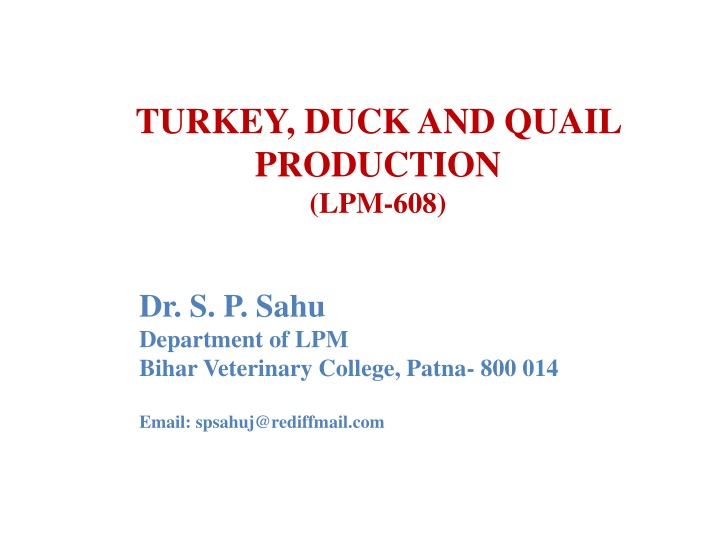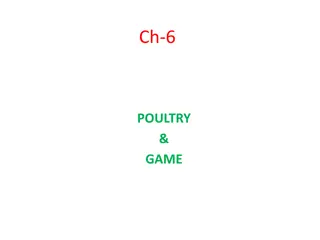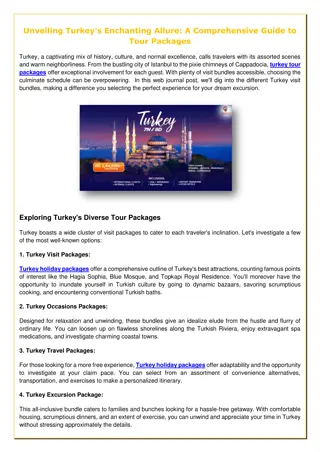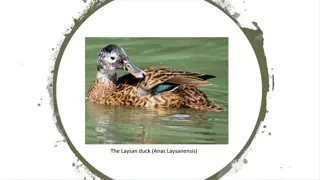Turkey, Duck, and Quail Production Overview
Turkey, along with duck and quail, plays a significant role in poultry production, contributing to economic and nutritional well-being. Different breeds of turkeys are found in India, with Kerala and Tamil Nadu being leading states in production. Various terminologies related to turkeys and their distinctive characteristics are also discussed.
Download Presentation

Please find below an Image/Link to download the presentation.
The content on the website is provided AS IS for your information and personal use only. It may not be sold, licensed, or shared on other websites without obtaining consent from the author.If you encounter any issues during the download, it is possible that the publisher has removed the file from their server.
You are allowed to download the files provided on this website for personal or commercial use, subject to the condition that they are used lawfully. All files are the property of their respective owners.
The content on the website is provided AS IS for your information and personal use only. It may not be sold, licensed, or shared on other websites without obtaining consent from the author.
E N D
Presentation Transcript
TURKEY, DUCK AND QUAIL PRODUCTION (LPM-608) Dr. S. P. Sahu Department of LPM Bihar Veterinary College, Patna- 800 014 Email: spsahuj@rediffmail.com
TURKEY PRODUCTION Turkey occupies an important position next to chicken, duck, guinea fowl and quail in contributing the most a significant role in augmenting the economic and nutritional status of human population. Contributes about 2% of the total poultry population. Reared for meat only and its meat is the leanest among other domestic avian species.
Indigenous and non-descriptive turkeys are found in good numbers in Kerala, Tamil Nadu, eastern districts of Uttar Pradesh and some other parts of India. Turkey (Meleagris Gallopavo) is a large gallinaceous bird of the family Meleagridae that is native of North America, domesticated in Europe and reared all around the world. Used to celebrate thanksgiving in month of November. Kerala and Tamil Nadu are the leading states in turkey production.
Breeds of turkeys in India: Board breasted bronze: The basic plumage color is black and not bronze. The females have black breast feathers with white tips, which help in sex determination as early as 12 weeks of age. Beltsville small white: This variety was developed in USA. It closely resembles the Board breasted white in color and shape but smaller in size. Egg production, fertility and hatchability tend to be higher and broodiness tends to be lower than heavy varieties.
Breeds of turkeys in India Board breasted white: This is a cross between Board breasted bronze and White Holland with white feathers. This variety was developed at the Cornell University. White plumage turkeys seems to be suitable Indian-Agro climatic conditions as they have better heat tolerance and also good and clean in appearance after dressing.
Turkey Terminologies: Tom: Adult male turkey. Hen: Adult female turkey. Poult: Young one of turkey. Snood or Dew Bill: The fleshy protuberance near the base of the beak. Caruncles: The fleshy protuberance on the head and neck usually pink or red in color which appear from about 5th Week of age.
Dewlap: A large flap skin seen immediately below the chin. Beard: A tuft of hair attached to the skin of the upper chest region. Strut: Mating behavior of male turkey. Shooting the red (Similar to an ulcer): The development of caruncles and this is supposed to indicate the most difficult time in the life of young turkey .
Debeaking: Poults should be debeaked to control feather picking and cannibalism and done at day old or 3-5 weeks of age. Remove the beak at about one half the distance from nostril to the tip of the beak. Desnooding: Removal of the snood or dewbill is to prevent the head injuries from picking and fighting. At the day old the snood is removed by shumbnail/finger pressure and at 3 weeks of age with sharp scissors. Detoeing or toe clipping: Clipping is done at day old by removing the tip of the toe just to the inside of the outer most toe pad including the entire toenail.
Turkey egg: Start lay from the 30th week of age and its production period is 24 weeks from the point of lay. Under proper feeding and artificial lightening management turkey hens lay as much as 60-100 eggs annually. Nearly 70 percent of the eggs will be laid in the afternoon. The turkey eggs are tinted and weigh about 85 gms. The protein, lipid, carbohydrate and mineral content of turkey egg are 13.1%, 11.8%, 1.7% and 0.8% respectively. The cholesterol is 15.67-23.97 mg/gm of yolk.
Turkey meat: People prefer turkey meat because of its leanest nature. The protein, fat, energy value of turkey meat are 24%, 6.6%, 162 Calories per 100 gm of meat. It is rich in unsaturated fatty acids and essential fatty acids and low in cholesterol.
Management Practices in turkey: Incubation: The incubation period is 28 days in turkey. There are two methods of incubation. (a) Natural incubation with broody hens: Naturally turkeys are good brooders and the broody hen can hatch 10-15 numbers of eggs. Only clean eggs with good eggshell and shape is placed for brooding to get 60-80% hatchability and healthy poults. (b) Artificial Incubation: The temperature and relative humidity in setter and hatcher are as follows: Temperature and RH in setter and hatcher is 99.5oF, 60-65% and 99oF and 85-90%, respectively. Egg should be turned at hourly intervals daily.
Brooding: In turkey 0-4 weeks period is called as brooding period. The floor space requirement for 0-4 weeks is 1.5 sq.ft. per bird. Poult guard of atleast 1 feet height provided to prevent the poults from wandering away from source of heat. Starting temperature is 950F followed by weekly reduction of 50F per week upto 4 weeks of age. Turkeys are not the best starters in their life and will really need some tender loving care through the first four weeks of life. The average mortality rate is 6-10% during this period.
Force Feeding: Starve out problem is one of the major factors for early mortality in poults. In force feeding, milk is fed at the rate of 100ml per liter of water and one boiled egg have to be given at the rate of one per 10 poults up to 15 days to compensate the protein and energy requirements. Litter materials: Thickness of the litter material: 2 inch at the beginning and increased to 3-4 inch by gradual addition. The litter is raked at frequent intervals to prevent caking.
Rearing systems: Turkeys can be reared under free range or intensive system. Free range system of rearing: In the free range system, in one acre of fenced land can rear 200-250 adult turkeys. Shelter should be provided during night at the rate of 3-4 sq.ft. per bird. They should be protected from predators during scavenging. Since turkeys are very good scavengers: consume earthworms, small insects, snails, kitchen waste and termites, which are rich in protein and that will reduce the feed cost by 15%. Apart from this leguminous fodders and calcium should be supplemented at the rate of 250gm per week per bird. Highly susceptible for internal (round worms) and external parasites (fowl mite) and once a month deworming and dipping is essential to improve the growth of the birds.
Intensive system of rearing: The height of the house may vary from 2.6 to 3.3 meters from the floor to roof. The floor of the houses should be cheap, durable and safe preferably concrete with moisture proof. When reared under deep litter system, the general managemental conditions are similar to that of chicken. The methods of feeding are mash feeding and pellet feeding. The energy, protein, vitamin and mineral requirements for turkeys are high when compared to chicken. Greens can be fed upto 50% of the total diet on dry mash basis. Fresh Lucerne is first class green feed for turkeys of all to reduce the feed cost.
BREEDING PRACTICES: Sexing: Physical appearance of Tom: 1. Toms are heavier. Matured toms have black bread attached to the skin of the upper breast region. 2. Dew bill or snood is relatively large, plumb and elastic. 3. Caruncles will appear in toms usually by fifth week. 4. life. Male poults strut even at day old and continue throughout the Hen turkey: 1. The dew bill or snood is relatively small, thin and non-elastic. 2. The bread and caruncles are absent.
Mating: The mating behavior of tom is known as Strut, wherein it spreads the wings and makes a peculiar sound frequently. In natural mating the male; female ratio is 1:5 for medium type turkeys and 1:3 for large types. Tendency in toms to develop affinity towards a particular female, so change the toms for every 15 days.
The artificial insemination is also done to maintain high fertility from turkey flock throughout the season. The age of tom should be 32-36 weeks for semen collection. Average semen volume is 0.15 to 0.30 ml. AI is done when the flock attains 8-10% egg production. Inseminate the hens every three weeks with 0.025- 0.030 ml of undiluted semen.
Marketing of turkeys: The dressing percentage of turkey is 80-87%, which is highest of all farm species. The body weight of tom and hen turkey at the 16th week is 7.26 kg and 5.53kg for marketing. The cumulative feed efficiency at the marketing should be 1:2.8 for toms and 1:2.7 for hens.
DUCK PRODUCTION Advantages: Need less expensive, simple and non-elaborate housing facilities. Very hardy bird and need less care and adopt themselves with almost all types of environmental conditions. Lay eggs either at night or in the morning: to collect their fresh eggs every morning and do other works during rest of the day. Need comparatively less space for raising ducks. Highly resistant to the common avian diseases.
Advantages . Feed your ducks with a wide variety of foods and have the natural tendency of foraging on aquatic weeds i.e. directly reduce feeding cost. Use ducks for controlling snails or harmful insects from the garden. Less mortality rate and usually live longer than chickens. Ducks lay eggs for a long time period. Duck products such as eggs and meat have a great demand in the market. Duck farming business can also be a stable employment source.
Peculiarity of Ducks The body of the ducks is fully covered with oily feathers, so water can t directly enter inside their body. Ducks have a layer of fat under their skin, which helps them from getting wet. Another peculiarity of duck is their legs. There are three fingers on their legs and covered with thin skin ( web ). It works as the paddle of a boat. Finger ends in nail which are used for defending themselves.
Peculiarity of Ducks .. Generally the lip of ducks are red or orange coloured and with this lip they can eat moss, insects, fish egg, hard snail etc. Usually hens lay egg all over the day, but ducks lay eggs at night or in the morning. So don t allow ducks to go out from their house before 9 AM.
Duck Breeds 1. Meat Duck Breeds: Usually meat productive male ducks weight about 5 kg and female weight about 4 kg. Pekin ducks have a large pure white body with orange beak and feet. Pekins are the most common domestic duck choice. Because of their huge body and skinny legs, they are prone to leg injuries. They are unable to fly. The Pekin breed is of Chinese origin. The Pekin is the best choice for anyone getting started with ducks. Rouen is another popular domestic breed that closely resembles a Mallard duck when fully mature. Unlike its smaller cousin, the mallard, the Rouen is too heavy to fly. They are said to be calm in nature. They originated in France.
Duck Breeds Muscovy is a "quackless" duck. Originally from Brazil, they are the only breed of duck that is not a descendant of the Mallard. Some can fly, it depends on the body size. Aylesbury: Aylesbury lays better than Muscovy and do not go broody. Their eggs may be greenish white. The tail is only slightly curved. This breed moves with a slow waddling gait. The pure white plumage should be bright and glossy.
2. Layer Duck Breeds: There are two main egg-producing breeds: Khaki Campbell and Indian Runner. Khaki Campbell is a bit larger and has a better carcase resale value than Indian Runner. Indian Runner: Indian Runner is a popular layer duck breed and very famous for their egg production capability. There are three types of Indian runner ducks available. White and grayish Indian runners are good layers. Indian Runners come in more than two dozen colours and stand tall and upright like a bowling pin. They are the most prolific egg layers, some laying upwards of 300 eggs per year. This breed originated in the United States before 1900.
Khaki Campbell: They are also very popular duck breed for high egg production. Ducks are a greenish bronzy brown colour and are excellent egg layers. They originated in England taking on the name Campbell, the developer of the breed. Khakis are a cross between Indian Runner, Mallard and Rouen. 3. Meat & Layer Duck Breeds: Khaki Campbell ducks are suitable for both meat and egg production.
Important Indian breeds of ducks Although, ducks alone contribute about 16% of the total egg production in India, their farming in well organised way is virtually non-existent. Ducks, due to their hardy nature, more egg production rate, less care during farming and disease resistant nature are easy and economical to culture. They can survive well on any type of soil with semi- aquatic conditions. In India the largest numbers of ducks are found in West Bengal followed by Assam, Tamil Nadu, Andhra Pradesh, Kerala and Bihar.
1. Nageshwari: They are found in district of Cachar and Sylhet of Assam and in parts of East Bengal. Major part of the body is black while the breast and neck are white in colour. The egg production rate varies from 100-150 per year. An average egg is about 60 grams in weight with pale blue colour. The adult bird has an average weight of about 2 kg.
2. Sylhet Mete: They are found mainly in Eastern India. Major part of the body is covered by light brown feathers with black tip, but the neck and head are blue. The number of eggs produced per year varies from 80-150. The average weight of an egg is about 56 grams and is of white colour. The weight of a fully grown bird comes to about 1.8 kg.
Housing The main advantages of duck production is their simple accommodation. Keep your ducks in low, high, wet, dry and any other places. Ducks like watery and wet place to live. Easily make a suitable place for ducks by using a big fruit basket, wood-speech or oil drum. Always make a door for entrancing and exiting, wherever you keep the ducks. The door need to be high enough. Because duck enter inside the house raising their head higher.
Housing Their house must have to be well ventilated and you have to ensure sufficient flow of fresh air inside the house. Usually each duck will require 2-3 square feet flooring space. To be ensuring the safety of your ducks. If kept ducks like chickens, in a concrete floored house, then have to make a deep litter inside the house with litter depth between 5-6 inches. In this system, ducks will lay eggs on the floor.
Feeding Ducks generally eat almost all types of food they find edible. You can feed your ducks like chickens. Add some extra additives into duck feed. As some ducks lay more eggs than hens, so you have to be very careful about feeding ducks. Add necessary nutrient elements in their diet. Always provide your ducks nutritious feed according to the various types of duck breeds and their growth rate. For small scale or domestic duck farming, feed ducks rich bran, kitchen waste and a plenty of snails. Ducks are voracious eaters however a well-balanced ration can result in larger number of egg production.
Breeding Water is a must for breeding purpose. One male duck is sufficient for breeding 10 female ducks. Usually high quality and productive duck breeds start laying eggs at their five months of age. Each egg weights about 50 to 60 grams.
Breeding . Use hens for hatching the eggs, instead of ducks. Do not keep the newly born ducklings in water during their first week after birth to prevent getting cold. Usually duck eggs take about 28 days to hatch. During the hatching period, sprinkle the eggs with water occasionally (two or three times per week).
Select breeders that are young and vigorous. The following will help you differentiate between young and older ducks: The leg and bill colour is bright in young ducks - in older ducks, it is dull and there is a hardening of the skin. Young ducks have a pliable, soft breastbone - the breastbone of the older ducks is rather hard. The windpipe of young ducks is soft and easily dented - it is difficult to dent the windpipe of older ducks.
Sex Determination: Raise the tail of the duckling and press on its anus. If you notice there is a penis like thorn, then it will be male. And if not then it will definitely be a female duck. The easiest way to determine male ducks is that the tail feathers of male ducks are curled up.
Ducks Eggs and Meat Market Marketing duck products (egg and meat) is very easy. People all over the world like duck egg and meat from the ancient time. In some areas, people like duck eggs and meat more than chicken meat or eggs. Duck eggs are usually larger in size than chicken eggs. Before marketing duck eggs, clean the dirt of egg shell perfectly. Don t wash the eggs with water. Clean the eggs with knife, soiled paper or towel. Use egg basket or carton for caring eggs from one place to another place. Make a deep layer of straw or rice bran if you use such boxes for carrying eggs.
QUAIL PRODUCTION Quail is dual purpose bird for meat and egg production. 2 breeds of quails: (i) Japanese quail (Coturnix Japonica) commonly known as Bater. Utilised for developing specialized egg and meat lines of quail. (ii) Bob white quail (Colinus virginianus): Birds are without tail, heavy and have white coloured plumage as dominant character. Broiler quails lines: CARI Uttam, CARI Ujjawal and CARI Sweta Egg type quails line: CARI Brown and CARI Pearl (White Egg Shell line).
Special features of quails Very short generation interval. very resistant to diseases. No vaccination is required. Low space requirement (200 sq. cm.). Easy to handle. Early maturity marketing age with in 4th week. Very high laying intensity: Female starts laying at an age of 42 days and reach to peak production by 10-12 weeks of age.
Other Information: Dressing percentage 70-75% Av. oven ready weight (28-35 days) 110-140g Killing out % no giblet 65% Average fertility 85-90% Average hatchability 65-75%























